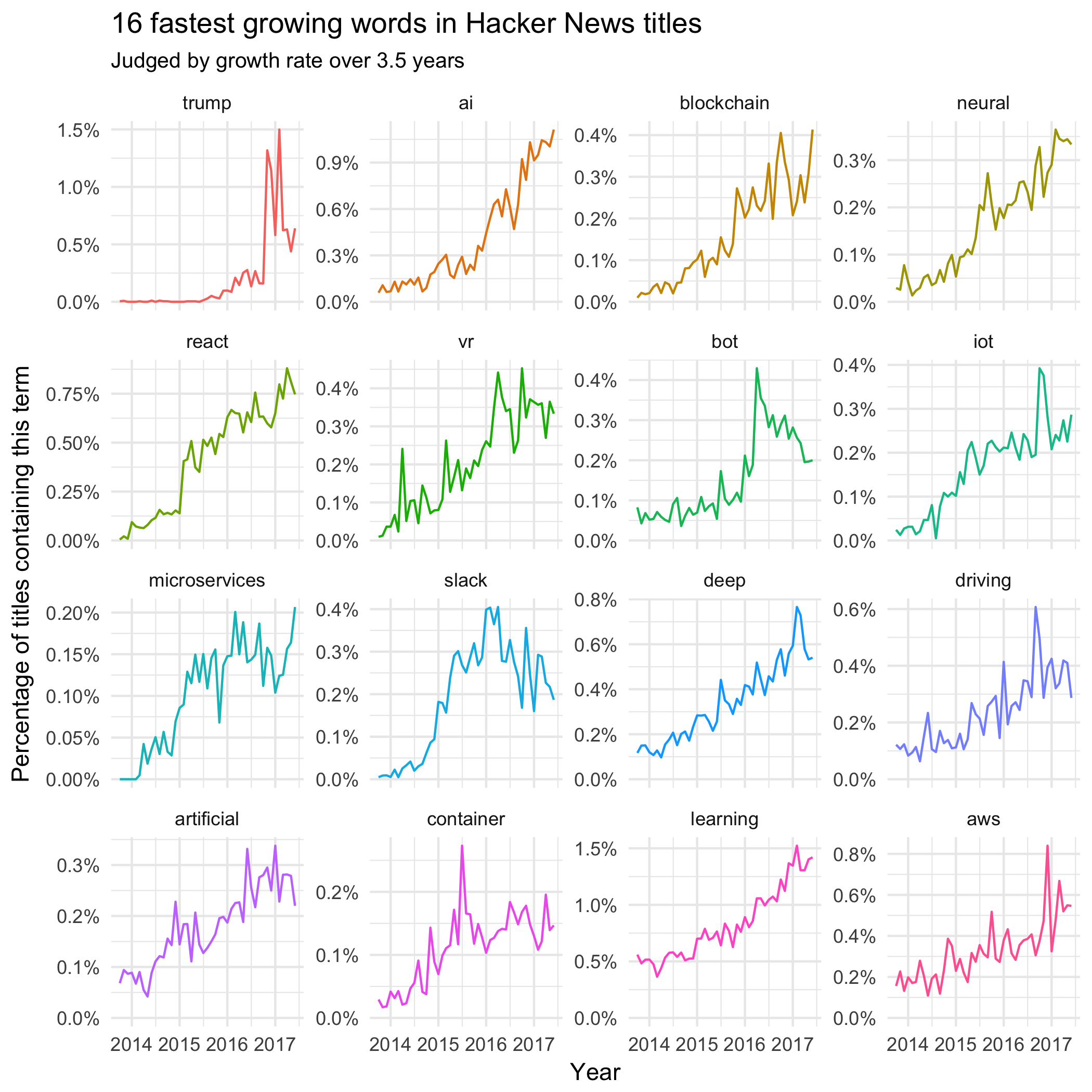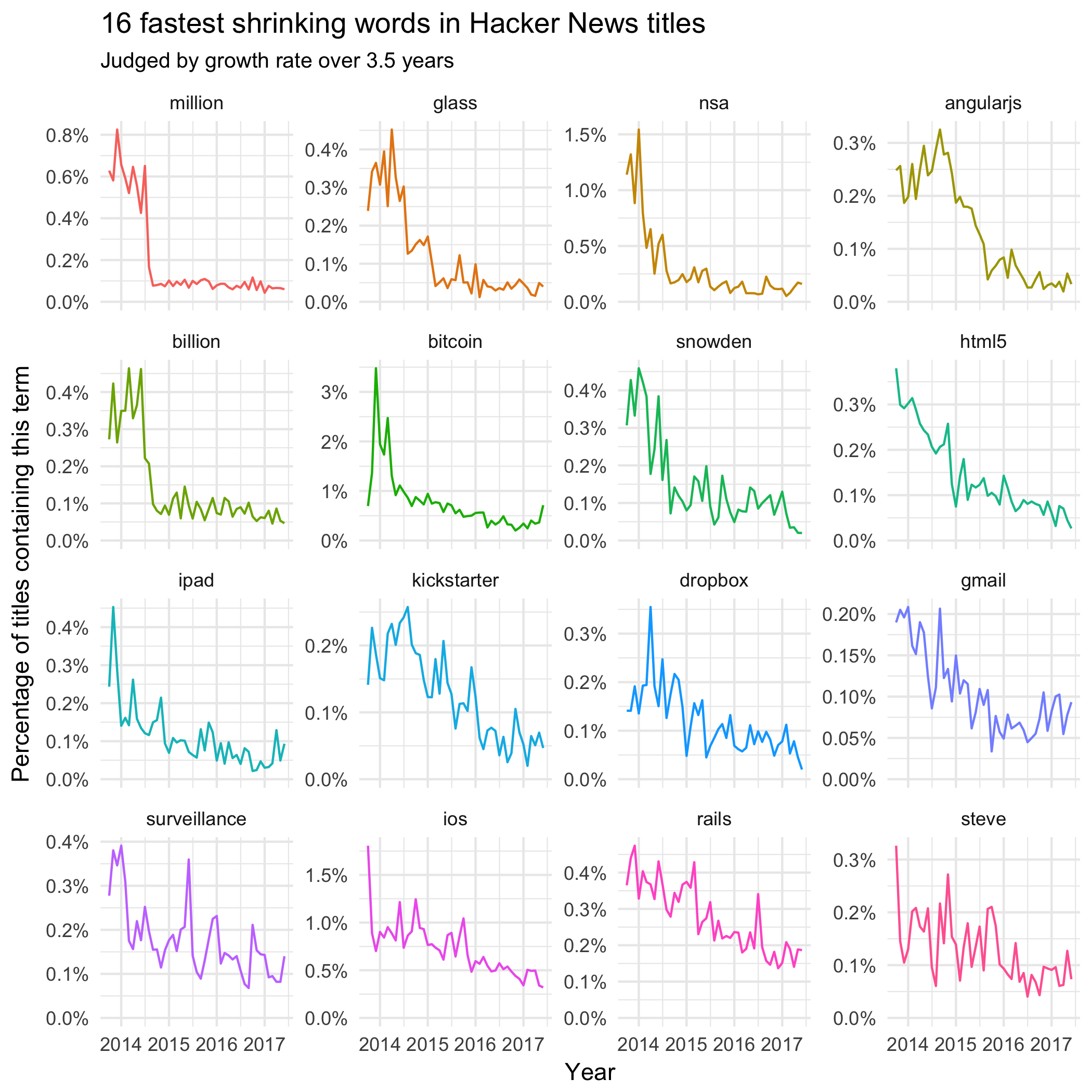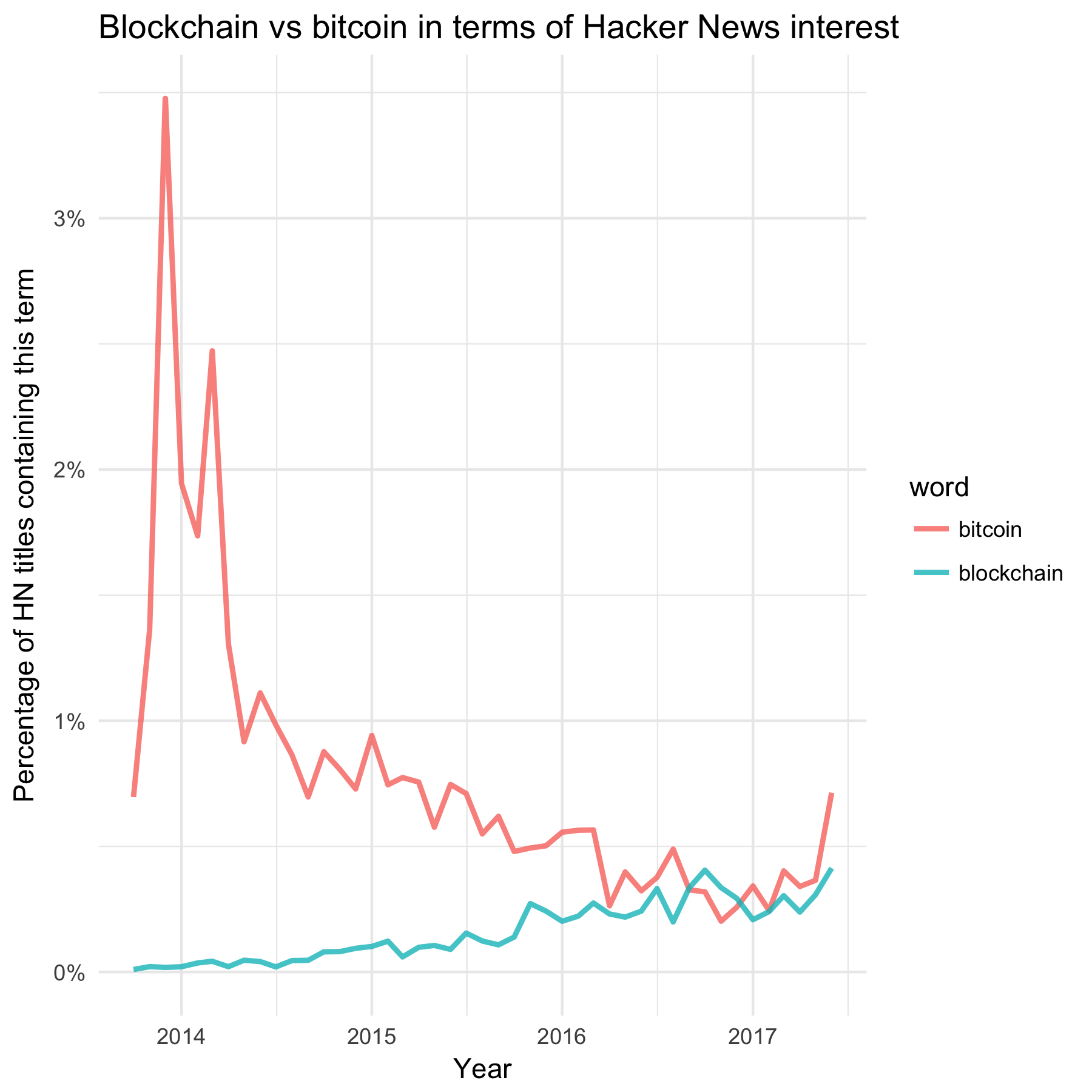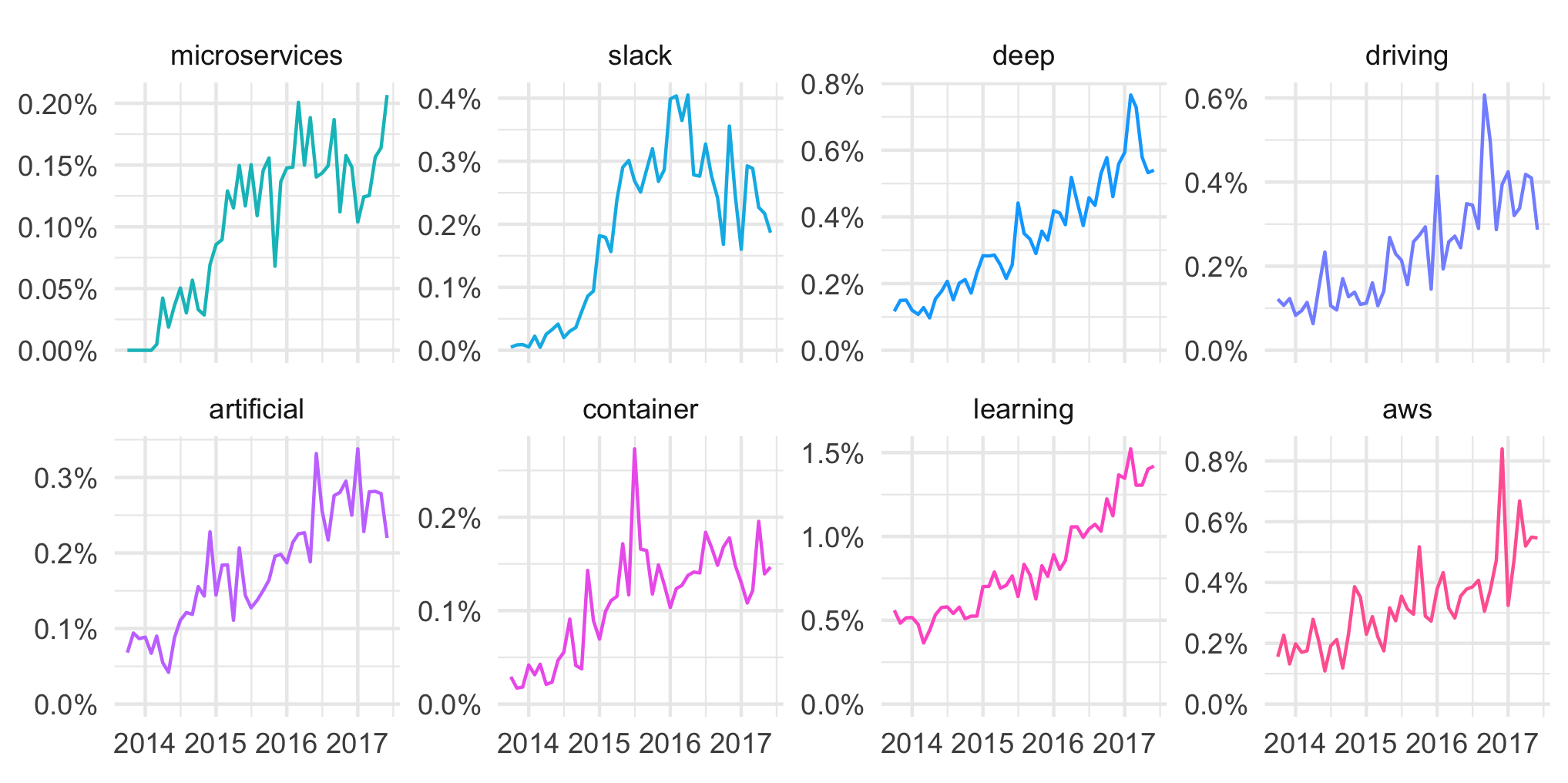Technology
What Ideas Are Trending Among Tech’s Biggest Influencers?
Y Combinator, one of best-known Silicon Valley accelerators, has an impressive track record of success. With well-timed investments in Dropbox, Stripe, and Airbnb, the startups in the company’s portfolio are now worth an aggregate of $600 billion in market capitalization.
While Y Combinator has made a clear impact on the tech sector, the company also launched an internal side project in 2007 that would end up becoming highly influential in a different and surprising way.
Its user-powered news aggregator called Hacker News, which is now visited by 20 million people per month, has become a mainstay for entrepreneurs, tech professionals, and venture capitalists around the world. Using a Reddit-like interface, users can upvote and downvote articles that they think have the most relevance to trends and issues affecting the tech sector.
Data Mining For Trends
Today’s charts come to us from Variance Explained, and they help to paint a picture of what topics have been trending on Hacker News over the last 3.5 years.
Using data from over 1 million subject lines, we can see which topics are being mentioned with increasing frequency by the site’s community of technology influencers.

As you can see, words like “AI”, “artificial”, “bot”, “deep”, “neural”, and “learning” are key terms that have growing interest within the community. It shows that the buzz around AI and deep learning is widespread and happening on multiple fronts.
Donald Trump was also a hot topic of debate in Hacker News, as evidenced by the increase in mentions.
Cooling Off
Here are some of the words in the community used with decreasing frequency over the same 3.5 year timeframe:

Over time, as the rubber hits the road, we get to see which ideas have staying power.
Google Glass, as cool as it was, ended up not directly revolutionizing how we use augmented reality. Likewise, Edward Snowden’s revelations about the NSA and surveillance seemed to have also dropped out of discussion.
On the flipside, some of these concepts also seem to have transitioned to the mainstream. Bitcoin and other altcoins, for example, are now more popular than ever before with a market capitalization of over $100 billion. Likewise, iPads, Gmail, and Kickstarter are pretty ubiquitous, but it could be argued that discussion on these topics is now pretty staid for the idea-hungry folks that frequent Hacker News.
Blockchain vs. Bitcoin
It’s also interesting to see the contrasting popularity of two related terms among Hacker News participants.
Bitcoin-related talk, at least on Hacker News, was hot in late-2013 after the price skyrocketed for the first time. The blockchain, on the other hand, took some time to pick up steam among influencers.

Fast-forward to today, and the concept of the blockchain is much more fleshed out.
It took time, but the blockchain is now considered to be a foundational technology that is affecting everything from how how stock markets work, to the proof of ownership for digital assets.
Technology
All of the Grants Given by the U.S. CHIPS Act
Intel, TSMC, and more have received billions in subsidies from the U.S. CHIPS Act in 2024.

All of the Grants Given by the U.S. CHIPS Act
This was originally posted on our Voronoi app. Download the app for free on iOS or Android and discover incredible data-driven charts from a variety of trusted sources.
This visualization shows which companies are receiving grants from the U.S. CHIPS Act, as of April 25, 2024. The CHIPS Act is a federal statute signed into law by President Joe Biden that authorizes $280 billion in new funding to boost domestic research and manufacturing of semiconductors.
The grant amounts visualized in this graphic are intended to accelerate the production of semiconductor fabrication plants (fabs) across the United States.
Data and Company Highlights
The figures we used to create this graphic were collected from a variety of public news sources. The Semiconductor Industry Association (SIA) also maintains a tracker for CHIPS Act recipients, though at the time of writing it does not have the latest details for Micron.
| Company | Federal Grant Amount | Anticipated Investment From Company |
|---|---|---|
| 🇺🇸 Intel | $8,500,000,000 | $100,000,000,000 |
| 🇹🇼 TSMC | $6,600,000,000 | $65,000,000,000 |
| 🇰🇷 Samsung | $6,400,000,000 | $45,000,000,000 |
| 🇺🇸 Micron | $6,100,000,000 | $50,000,000,000 |
| 🇺🇸 GlobalFoundries | $1,500,000,000 | $12,000,000,000 |
| 🇺🇸 Microchip | $162,000,000 | N/A |
| 🇬🇧 BAE Systems | $35,000,000 | N/A |
BAE Systems was not included in the graphic due to size limitations
Intel’s Massive Plans
Intel is receiving the largest share of the pie, with $8.5 billion in grants (plus an additional $11 billion in government loans). This grant accounts for 22% of the CHIPS Act’s total subsidies for chip production.
From Intel’s side, the company is expected to invest $100 billion to construct new fabs in Arizona and Ohio, while modernizing and/or expanding existing fabs in Oregon and New Mexico. Intel could also claim another $25 billion in credits through the U.S. Treasury Department’s Investment Tax Credit.
TSMC Expands its U.S. Presence
TSMC, the world’s largest semiconductor foundry company, is receiving a hefty $6.6 billion to construct a new chip plant with three fabs in Arizona. The Taiwanese chipmaker is expected to invest $65 billion into the project.
The plant’s first fab will be up and running in the first half of 2025, leveraging 4 nm (nanometer) technology. According to TrendForce, the other fabs will produce chips on more advanced 3 nm and 2 nm processes.
The Latest Grant Goes to Micron
Micron, the only U.S.-based manufacturer of memory chips, is set to receive $6.1 billion in grants to support its plans of investing $50 billion through 2030. This investment will be used to construct new fabs in Idaho and New York.
-

 Education1 week ago
Education1 week agoHow Hard Is It to Get Into an Ivy League School?
-

 Technology2 weeks ago
Technology2 weeks agoRanked: Semiconductor Companies by Industry Revenue Share
-

 Markets2 weeks ago
Markets2 weeks agoRanked: The World’s Top Flight Routes, by Revenue
-

 Demographics2 weeks ago
Demographics2 weeks agoPopulation Projections: The World’s 6 Largest Countries in 2075
-

 Markets2 weeks ago
Markets2 weeks agoThe Top 10 States by Real GDP Growth in 2023
-

 Demographics2 weeks ago
Demographics2 weeks agoThe Smallest Gender Wage Gaps in OECD Countries
-

 Economy2 weeks ago
Economy2 weeks agoWhere U.S. Inflation Hit the Hardest in March 2024
-

 Green2 weeks ago
Green2 weeks agoTop Countries By Forest Growth Since 2001















